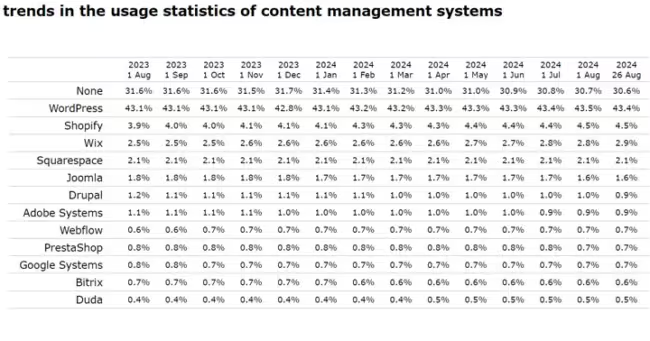Last year, we wrote an article about WordPress’ 20-year celebration and shared our expectations for its future. We believe that publishing an annual article on WordPress predictions and expectations would greatly interest our readers. Not only does it highlight how WordPress has evolved over the past year, but it also provides a strategic perspective on its future. Of course, some of our predictions may be inaccurate, so we encourage you to share your insights and contribute via the comment section.
Current State of WordPress

WordPress has established itself as a mature project, supported by a large community of enthusiasts who work hard to make it even better. It’s noteworthy that its growth rate has leveled off over the past two to three years. W3Techs likely the most widely used source for technology usage statistics, confirms this trend—WordPress powered 43.1% of websites using a content management system (CMS) in August 2023, and 43.4% in August 2024.
Joost de Valk, the founder of Yoast, has done an excellent job by publishing independent data on WordPress market share. While he uses a different methodology than W3Techs, what truly matters is that, according to his research, WordPress is used by 35.36% of websites running on a CMS. Notably, both sources place WordPress in the top position by an astonishing margin. For context, Shopify, the second-largest CMS in all rankings, holds a market share of less than 5%.
Two additional factors demonstrating WordPress’s maturity are the scale of acquisitions within its ecosystem and the increasing difficulty for small agencies to develop highly successful products. Companies like Automattic and Awesome Motive have invested astronomical amounts of money in acquiring various projects. In this environment, it’s clear that small teams have little chance of creating a product with a significant market share.
Previous Predictions
In our previous article, we predicted continued refinement of the user experience, the rise of block themes, and improvements to WordPress Playground. These short-term predictions have been confirmed this year. Each new WordPress iteration has brought enhancements to the Gutenberg editor, providing users with a more polished experience. Although no block-based themes have yet achieved widespread popularity or developed a large fanbase, the number and quality of these themes are growing substantially. We may soon see 1,000+ block themes in the WordPress theme directory. WordPress Playground is also becoming increasingly popular; now, you can use it even without an active Internet connection or use it as a Progressive Web App.
The medium- and long-term predictions can’t be confirmed or infirmed in such a short period.
Short Term Predictions

The maturity of WordPress brings both advantages and disadvantages. We strongly believe that more acquisitions will occur in the coming year, with many established companies entering the WordPress market. This is a positive development, as it means more investment in improving and enhancing WordPress. However, the enthusiasm of online entrepreneurs is falling down. Significant capital is now required for both production and marketing to bring a product to market, making it nearly impossible to compete with large companies with vast budgets. As a result, WordPress is becoming more attractive to investors than to entrepreneurs.
WordPress enthusiasts can contribute to each new version of the CMS. It’s likely that more and more programmers, designers, and even regular users will express their ideas to improve WordPress. In fact, WordPress’s market share is unlikely to grow unless more people contribute to its development as a CMS. We can expect larger groups of enthusiasts to contribute to WordPress, seeking recognition within the community. While their opportunities to launch new products may be limited, it’s natural for them to contribute to WordPress as a way to attract the attention of recruiters.
Data Liberation is an interesting project that started in 2024 and should be on your radar in 2025. The core idea of the project is simple yet powerful—helping users avoid becoming prisoners of platforms. It aims to give users the ability to export and import their content with a single click. This easy website migration process is a significant step forward for users and will likely stimulate competition between CMSs. However, there isn’t yet any concrete information regarding the project’s implementation.
Medium Term Predictions
WordPress long term roadmap is currently in the 3 out of 4 phases. Phase 1 (Easier Editing) and Phase 2 (Customization) have already been completed, while Phase 4 (Multilingual) is on the horizon. Revamping the WordPress dashboard is a key component of Phase 3 (Collaboration), and it involves a significant amount of collaborative effort. Users are familiar with the current dashboard, so any changes may pose challenges for them. However, a redesign is necessary, and many skilled designers are actively working on this project. Anyone is welcome to contribute, so feel free to join the Slack discussions. While it will likely take more than a year for the new dashboard to be fully implemented, it’s clear that an upgrade is coming in the mid-term.
In our previous article on WordPress predictions, we included AI usage in the long-term perspective. While its major impact is expected to be felt over the next decade, AI has already begun to influence the WordPress ecosystem. It’s only a matter of time before WordPress themes or plugins include AI modules that can create pages or UI elements based on users’ prompts.
You’re probably tired of reading countless articles about optimizing your website’s loading speed. While these tips are helpful, placing all the responsibility on users isn’t the most productive approach. WordPress should be faster by default, and themes and plugins should be more lightweight. Although there has been progress in this direction, there’s still plenty of room for improvement. We expect to see a faster and more mobile-friendly WordPress ecosystem. This won’t happen overnight, but each new version should bring incremental improvements.
Long Term Predictions

It may be bold to predict that we’ll celebrate WordPress’s 30th anniversary with the same market share, but it’s hard to imagine another CMS overtaking its leadership. All of its significant competitors currently hold market shares 8 to 10 times smaller, leaving no CMS in a position to challenge its supremacy. A new and better CMS would need many years in the market and a strong community to support it. In other words, WordPress is likely to remain a leading option even in 2035 and beyond, possibly still as the dominant CMS.
Currently, there isn’t much information available about Phase 4, but simplifying and enhancing WordPress’s multilingual features will be a significant step forward in meeting new user needs. Entrepreneurs will particularly appreciate the ability for their customers to easily switch the website language to their native one.
Over to You
We don’t have a crystal ball, so our predictions might not always be accurate. However, we are confident that at least our short-term predictions will prove true. Having a clear perspective on the future of WordPress can help you better prepare for what lies ahead. Feel free to share your thoughts and discuss what the future holds for us!

Leave a Reply